The TVS Apache RTR 180, it’s been the most awaited bike on Indian soil after the Ninja, it also happens to be the most powerful and the most expensive production bike in TVS catalogue. The men at the company have managed to give it all that a bike in its class would need, power, looks, handling and the extra touch. We take a really close look at this flagship model and ask ourselves what it’s really made of.
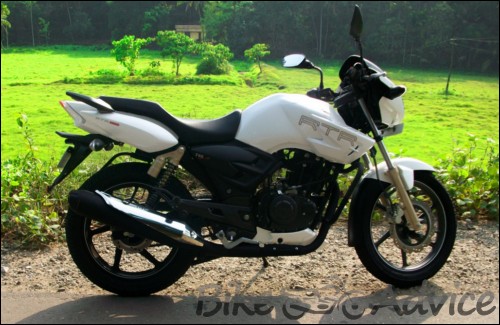
A little history: The Apache, it’s been around for a couple of years now, and from being the refreshing 150cc bike with lots of power it has, over the years, evolved into something worth appreciating.
To really know what a bike is all about, one needs to look into it’s history. You may know the famed TVS – Suzuki Fiero which was the result of the partnership between TVS and Suzuki, well this bike, or precisely, the engine of the Fiero is what the Apache 150, 160 and even the new 180 is based on. Just like the engines of the Honda Unicorn or the Hero Honda bikes, it’s a Japanese design, another less known or an often overlooked fact is that TVS has been involved in racing since 1984 and over the years, it has won over 90% of the 270 plus events it had participated in.
In short, TVS has been quite simply the most successful racing team in the country. Like almost every other manufacturer involved in racing, the company has implemented whatever it has learned in its 25+ years of racing into it’s bikes and specifically, the Apache’s. Since 1995, almost all bikes in the TVS racing garage featured the TVS Fiero / Apache engine, in various set ups and tuning stages, some as highly tuned 150cc’s and some as water-cooled, four stroke, four valve, 250cc’s and as a result, TVS often used “Pure Race breed / Race Derived” is true to its word, one that has been written about in the ‘racing’ sections of most Indian auto magazines.
The whole essence of this engine is that is built to a standard, which is well beyond what any user, whether an average rider even an engine abuser, would put it through in its entire life cycle. Hence it supports performance tuning, to a much higher extent than any other bike in the country up to 250cc, it can produce as much power as one would like. Also as an added advantage, it could handle it all reliably. Now that the history part has been taken care of, let’s take an even closer look at the Apache RTR 180.
Looks and Features: White as a color has long been ignored by most manufacturers, of course, it’s been applied to the police bikes in recent times but no one really thought that it would be considered as a great color choice for a production bike. This bike features a pearl white paint job with silver/Grey decals all around. The tiny flakes on the painted surfaces that glitter in the sunlight stand testimony to the quality of the paintwork.

For the looks, we gotta hand it over to TVS for the new striking color and sticker combination, it manages to stand apart from the crowd and is really eye catching. The stickers also change color based on how you look at it, going from grey to silver.
There are also several spots on the bike where you would notice the attention to detail that has actually gone into the design of this machine, take for example the keys, the fob has the same design as the gearbox, the under body protector, which seems to have taken days on the drawing board to create, the proudly designed RTR 180 logo on the rear sides and on the handlebar center plate, the silencer shield with IDI engraved on it, all of them show that the job of design was taken a bit seriously.
There are several additions have been implemented by TVS to make it stand apart from its little 160cc brother, such as golden powder coated shocks, white wheel stripes, white faced tachometer and a different rear fender design. The bikes feature list is quite long yet we have included the ones worthwhile: Rear Disc Brakes, Removable rear fenders, 0-60 timer and a top speed recorder, Matt black split adjustable handlebars, rear set foot pegs, illuminated key ring and forged aluminum levers.
One feature worth appreciating on the RTR is the time display on the speedometer, its especially helpful during night time riding since all you have to do is look at the speedo to know the time, rather than glance at the watch under a streetlight while taking the eyes of the road, this was also featured on the Karizma and can be of great aid very often. The split handlebars have an advantage as in case of a handle getting bent or damaged, all one has to do is replace the damaged piece rather than the whole set.
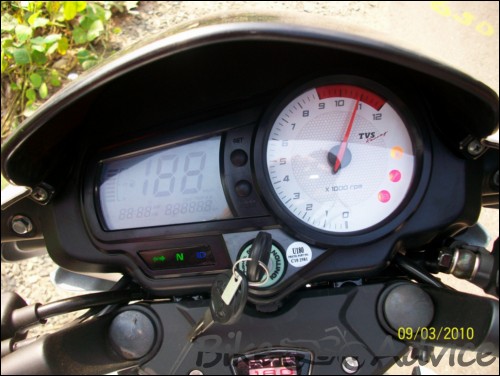
The removable rear fenders are a functional thought but it requires you to have a tool kit and a few screws to attach / remove it. The service indicator also saves the rider the need for calculating the Km’s remaining for the next service. Other features such as 0-60 timer and the top speed counter help the user to understand his machine a little better, for example, the 0-60 lets rider understand when to shift gears to have the best launch, the time is displayed for each run and by comparing the results, he could understand how to achieve the fastest take off or acceleration with this feature.
It can be helpful for someone who might undertake in drag racing. The quality of all the components, from the welds to the gear lever to the well designed speedometer are better than ever before, the front fairing, tank scoops, or any other part I could think of, showed absolutely no audible signs of rattle or vibrations at up to 10,000 RPM; Hats off to TVS.
Engine and Performance: This part really needs no more introduction. The RTR 180 features an over-square 177cc which produces 17.3 PS at 8500 RPM along with a torque figure of 15.5 NM @ 6500 RPM. These specs were never before seen on four stroke, twin valve, 180cc bike, the total kerb weight, despite all the improvements, was painstakingly kept the same as the RTR 160 at 137kg. The R180 is often compared to the Pulsar 220 because; in terms of real world performance, it is way ahead of the Pulsar 180 in more ways than one. Just to give you an idea, here are a few of the comparo figures, between the new Pulsar 180 and the RTR 180:
Pulsar 180
0 – 60 kmph : 5.08 secs
0 – 100 kmph : 15.8 secs
Roll on : 30 – 70 kmph in 5th gear : 14.6 sec
Kerb Weight : 147 kg
RTR 180
0 – 60 kmph : 4.45
0 – 100 kmph : 13.1 secs
Kerb Weight: 137 kg
Roll On : 30 – 70 kmph in 5th gear : 10.1 sec
Well, that was what it’s like on Paper, here’s what it’s like in the real world. Fire it up and you hear the louder yet familiar RTR 160 engine note.
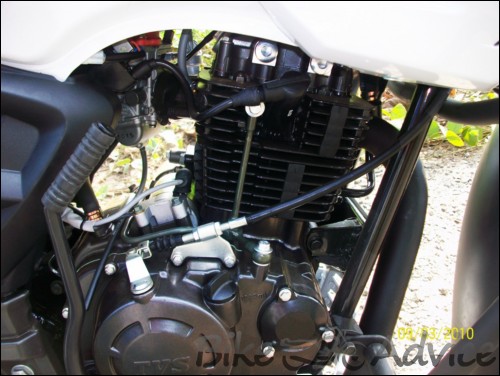
Release the clutch lever and you instantly notice the machines eagerness to move forward, you really need no throttle at idle speeds and the bike chugs forward, give it a little gas and it accelerates smoothly, no jerks here as I thought, the gearbox has been improved a lot and feels quite different to the older RTR 160’s. Slot it into 5th gear and the bike feels settled and silent at cruising speeds of around 60 – 70 kmph. I was honestly looking forward to finding a nice clear stretch of road where I could have the throttle wide open as the bike seemed to yawn at me.
So I turned over to the national highway and since it was just 2:00 in the afternoon, I was in for a treat. The roads were near empty. I Pulled over to the side, lowered the helmet visor, tuned on the headlight, took a breath, and slotted the gear into 1st. Ready, set, go! In the blink of an eye, the tacho needle just shot up and the engine roared into life, within a second or so, It hit the red-line and the speedo showed 40km/h, the front wheel was off the ground at this point, the next thing I know I was shifting into third when the needle showed 60 in second gear, Went forward and touched 85 kmph in third gear and from this point on the wind noise become prominent.
A moment later, the speedo showed 103 in fourth and a while later, 130kmph in fifth gear. After all that action, I slowed down to a steady 60kmph with my heart beating all over the place, it suddenly became something different, all silent and serene. At 60kmph, the only thing I could hear was the wind in my helmet, it was simply calm. Point to note is that the bike easily revs beyond the redline due to the lack of the rev limiter and after about 125 kmph, the needle would be hovering beyond red line. As long as you stay crouched down, it would still continue to climb, though not recommended on public roads. The exhaust sounds it’s very best after 6k Rpm, this can truly make you smile and at that RPM’s it turns into a loud and almost raw ‘grrr’.
Also, as soon as I shifted to 5th gear, I could hear that the exhaust note had a lot more bass to it, in short, the exhaust is tuned, just for the rider and it complements the strong engine that lurks beneath. The bike can easily set your pulse racing with all of its rawness and attitude, I just couldn’t keep myself from twisting the throttle every time I looked at the empty road ahead. As performance has always been the forte of the Apache, this bike never ceased to impress through all that I put it through, It performed equally well in the city and slow moving paces.
You could easily win most of the traffic light drags that you may put this bike through. Its nimble nature makes it a treat in traffic situations. It never feels awkward and can often mistake you for being a bigger cc bike. I’ve felt to be as fast as or even better than the Hero Honda Karizma the during the acceleration test. For a comparison, the RTR has a power to weight ratio of 126PS/ton, the Karizma R has a ratio of 113.3 PS/Ton, the Karizma ZMR has a ratio of 110.06 PS/Ton and I am confident in the fact that the Apache 180 can comfortably win a drag or even a race around a track with the famed Karizma’s which are a good 40cc’s bigger.
Ride and Handling: The Apache’s had established themselves as great handling bikes ever since the launch of the 150, it seems that TVS follows a motto of ‘Power is useless without control’. The RTR 180’s longer wheelbase gives it even more confidence than the 160 at high speeds or even with a pillion on board. Its cornering abilities are remarkable, one thing you would like is that around the twisties, on smooth road, the only part that would touch the ground when you lean the bike to the limit is the tiny knob on the footrest, as soon as it touches the ground, it vibrates with the road, this does not shake or affect the bikes stability as the footrest is designed to bend inward in case of high angle leans.
This is sort of like a warning that asks you to back off a tiny bit, and boy does it lean, you could have your knees scraping the tarmac within a few kilometers of riding the bike, the angles this thing is capable of achieving is amazing, at such limits, the fact that the bike has been tested to perform well under these conditions provides you with a sense of safety, the suspension damps any of the irregularities you may encounter mid corner.
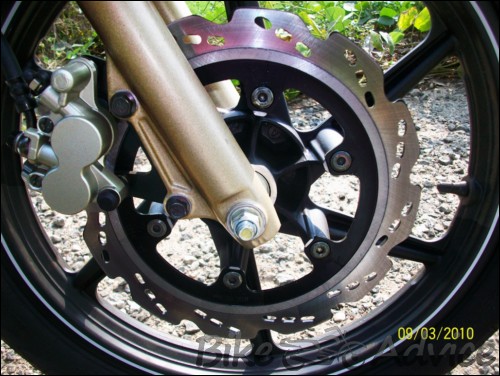
The weight around the whole bike is also well balanced and its nimble character allows you to level the bike up in the blink of an eye just in case you were to spot any potholes or problems in the road ahead while in a lean. This adds to the confidence, it gets you to appreciate the bike, it generates a sense of safety and generates confidence. It would remind you about TVS’s ‘race bred’ claim, which you would slowly start to believe in the more time you spend with the bike. As for the ride quality, it’s almost entirely dependent on the rear damper preload you set it at.
There are 5 settings from soft to hard, if you were to set it at soft, the ride becomes really comfortable, almost as good as the Yamaha Fazer, put it to hard and it stiffens up like a rock, do note that there is a tradeoff in changing the above settings, a soft setting would make the ride very comfortable but it would reduce the ‘feel’ of the road, the soft setting makes the bike feel like its floating on the road for some reason but, with the nicely shaped seats, it can increase comfort over long or bumpy journeys by a wide margin.
The hard setting is the stiffest, it’s more suited for use only on really smooth roads or track purposes, it is really rewarding for the seasoned rider as this setting gives the best feel, control and confidence. The bike stays stiff under almost any type of cornering but the problem is that the ride would turn into a punishment if it is used on bad roads, you could run over a spider and tell how many legs it had, you would have to stand up on the foot pegs when you see a pothole coming your way. It becomes that hard. Overall, it’s the setting that defines the ride quality, TVS provides a tool in the toolbox to adjust these but you could just turn it with your hands by twisting the upper part of the springs.
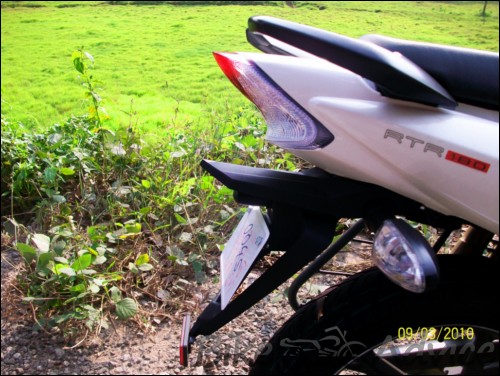
For RTR 180 owners, the deepest groove in the rear shock absorber is the softest and the highest groove is the hardest. Factory sets it right in the middle, not too hard, not too soft. The amazing part is how versatile the bike actually becomes with this feature, one minute your back is crying at you for the rough ride, the next; you are gliding across the same road with barely even a nudge, this does not change the behavior of the front suspension which seems to be neither to hard or too soft.
The tyres and brakes combination works well but that’s the only part that needs a little improvement, the TVS tyres, work really well on normal tarred roads, but it doesn’t feel reassuring when the road is covered in mud or any other slippery surface. The disc brakes needs to be used carefully under these conditions and must be let go of as soon as the front wheel feels like it has locked. I think this is the reason why TVS has been experimenting with ABS for the RTR line of bikes.
On the roads, it’s all fine, even during the high speed sessions, the bike felt really stable and the tires never gave a reason to complain. Its only when the roads are slippery that one has to be careful, it’s not that the bike just slips and falls, it doesn’t give the feedback on such surfaces, hence the rider should be careful when taking it off road. It’s always a good idea to find a muddy patch of road to test the braking limits at various speeds for any bike. This would prepare you for any emergencies that you may face. Apart from that the braking on the bike was really something to mention, the combination of the two disc brakes was really powerful plus the seating position never made the arms stressed during hard braking, in effect, at 80 Kmph, full brakes (60% front and 40% rear), it feels like stopping while zooming in with a camera, looking at its viewfinder.

There’s no fuzz, it doesn’t dive much, no screeching noise, you could feel your abdomen being pushed to the tank but nothing else, it’s just that a few seconds later, you are standing still at 0kmph on the road. I was honestly worried of being hit from the back by a car or a lorry and had made it a point to look carefully at the rear view mirror before I even thought of braking hard, the brakes were that good, and this also demonstrated what the tyres were capable of.
Though the rear disc does its job beautifully, a drum brake version as an option like in the RTR 160 could have been a good idea, though the disc brakes are powerful, it seldom works as well in the rain, so if you are the one who likes to ride in the rain, the rear disc could under perform when wet. But this can be viewed as a safety measure as it’s never safe to brake hard on any bike when it’s wet.
Overall the brakes and tyres do their jobs really well, there are few situations where the tyre shows signs of weakness but otherwise, they are both well and good. In my research, I had learned from the RTR 160 owners that the tyres seem to have a high tread life, it lasts up to 40,000 Km’s under normal use. This could be due to the use of a harder compound of rubber which lasts much longer but doesn’t grip as good as the soft ones, the tyres definitely felt better than the ones used in the RTR 160, in fact the rear tyre was actually wider and shorter than the 160’s.
Negatives: No review would be complete without a few bits of constructive criticism and here comes. The RTR is not exactly a one-size-fits-all bike, people beyond certain heights have often complained of it being small for them, I’m 5 feet, 10 inches with a weight of 75kg, for me though the bike fits like a glove, This bike is for a people within a certain height. Those who find it perfect would really turn away at the sight of any other bike, it’s always a good idea to test ride it before a final decision on purchase is taken.
The tyre performance is better than before, but on muddy surfaces, it needs a little improvement, TVS seems to have found a solution in the form of the ABS system, but until its implemented,a better brand of rubbers ( tyres ) would be the best solution. Vibrations, this isn’t such a big issue as some people suggest it to be, I used a pair of leather riding gloves and couldn’t feel this phenomenon myself, I personally found no reason to complain even after having ridden for quite a long time, the 180 has heavier bar end weights and several damping solutions in place compared to the 160 and this could be doing the trick. Basically, it’s all a matter of preference, if you are looking for engine refinement,
Unicorn is all yours, but if you want a raw power, and engine reliability, the RTR is the answer. Front faring, for the speeds this thing is capable of achieving, it really needs a full front fairing, if I were to buy this bike, I would have contemplated cross fitting the Fazer fairing into this one on the very first day. I’m sure that the next Apache (220 / 250 it at all launched) will have a fairing that will be as easy as plug and play for the RTR 180, until then, it would be a good idea to hold on tight. The branding, the Ad’s of the RTR 180 is one of the best I’ve seen for a bike, but TVS needs to work on their brand (the ‘TVS’ brand, not ‘Apache’ which is well taken care of)and its perception, people need to get an idea about what the company really is today, rather than what was 10 years back.
The Verdict: This bike demonstrates that TVS has taken the Apache brand really seriously, a close look at the bike shows that they have paid attention to even the tiniest detail from the ride comfort to the handling to the engine. They seemed to have worked even harder to create the 180 and considerable amount of time seems to have been spent on this machine, evident by the power figures and the weight which TVS kept the same as the 160.
It’s really a commendable effort, this machine has enough power to give the bigger cc bikes the chills and a run for their money. Their amazing ad campaign where they depict the bike as a racers dream is truly appealing. I honestly have never liked an Indian bike as much as this. Its Genuinely Cool. The strong points of this bike are the engine, handling and lightweight.
So there you have it, the RTR 180, to the last detail. In a nutshell, in stock form, you could race this bike all day long every day of its life without it even breaking a sweat. With its Japanese history, it’s just a simple fact that this bike is one of the most reliable machines in the country. But that’s a fact people rarely know. But it’s the lucky owners who, with each progressing day, discovers the fighter inside this truly amazing bike.
– Arun Thampi


